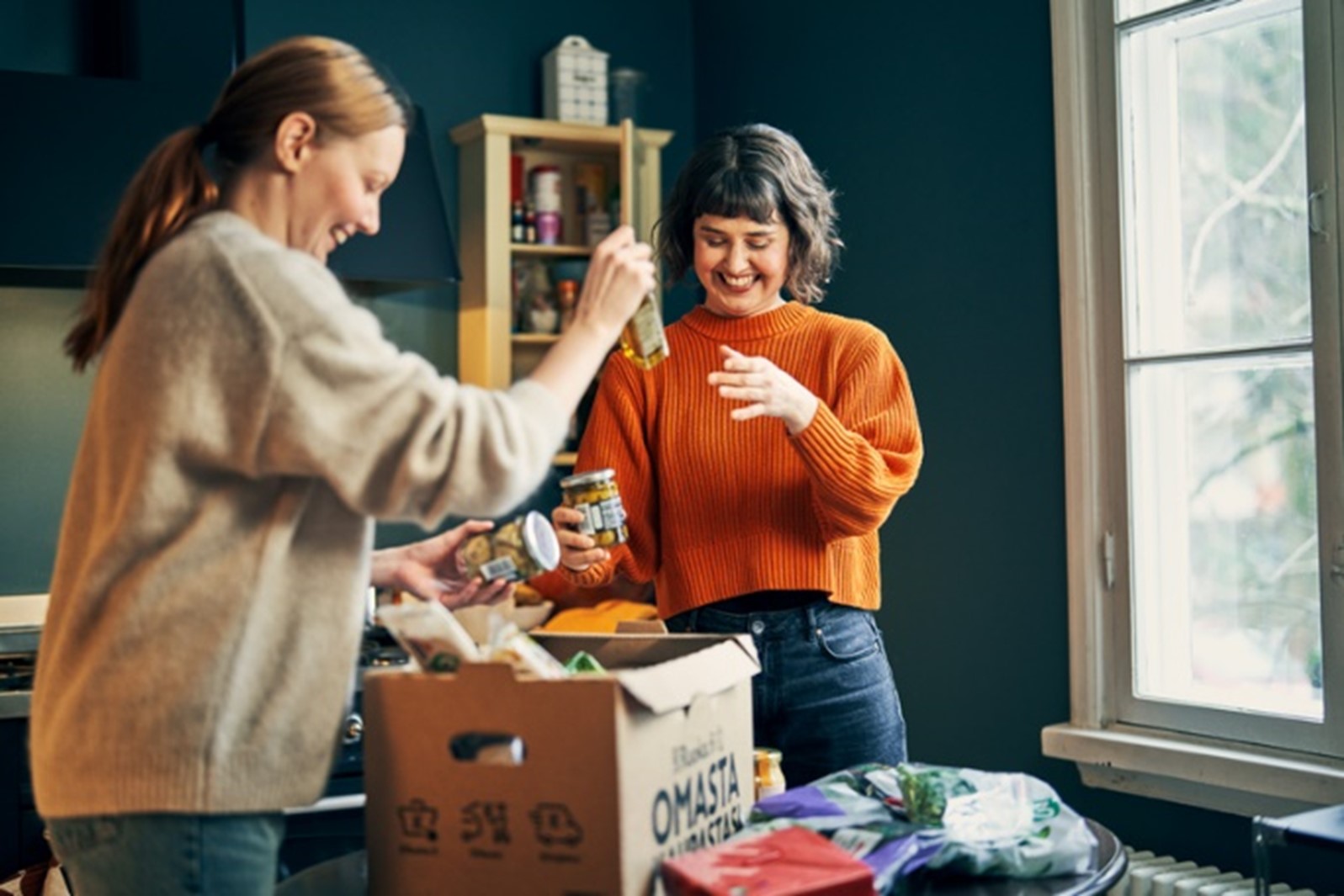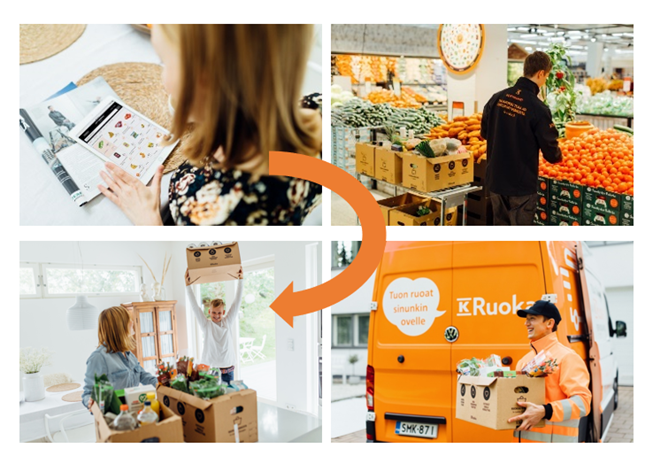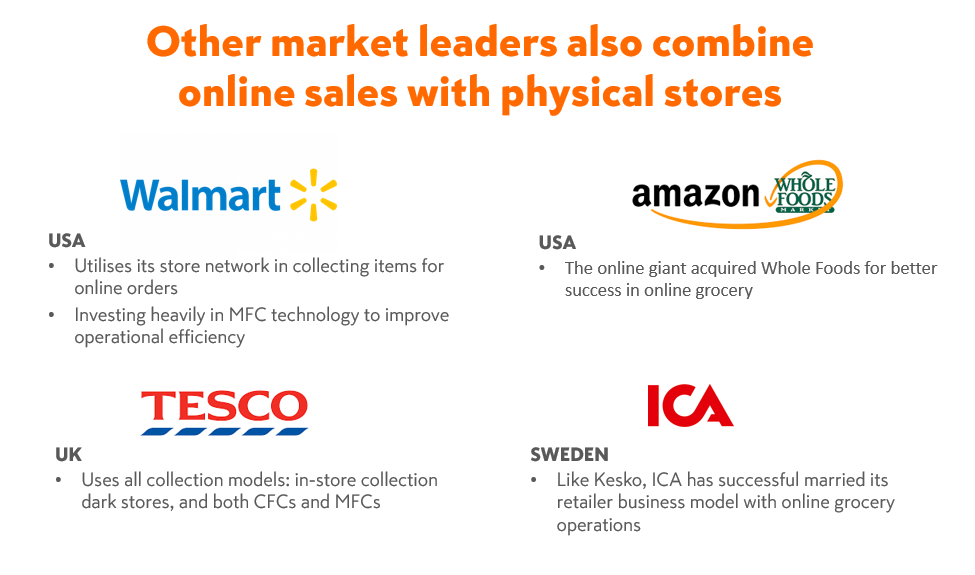

Investor blogs and podcasts
In Kesko’s investor blogs and podcasts, Kesko’s management discusses topical issues relevant to investors and shareholders.
IR Blog: What's the latest in Kesko's online grocery?
An increasing number of Finns now do their Christmas food shopping online. The online grocery business is developing and growing at a steady pace. The operating model chosen by Kesko – which marries online grocery sales with K Group’s physical grocery stores – has proven effective and profitable. Kesko estimates that it is currently the market leader in the Finnish online grocery business. Positive performance in online sales supports Kesko’s overall market share in grocery trade. Online grocery also plays an important part in winning over and retaining customers, as people who shop in multiple Kesko channels tend to buy more and be more committed.

Last year, K Group (i.e. Kesko and the K-retailers) sold groceries to consumers online for a total sum of 236 million euros (incl. VAT). If we include the sales of Kesko’s B2B foodservice arm Kespro – where 70% of sales come through digital channels – the sum for online food sales in 2022 rose above 950 million euros.
K Group hosts the most comprehensive network of stores offering online grocery services in Finland, comprising nearly 700 grocery stores across the country. The number of weekly deliveries is approximately 90,000. In 2021, we piloted fast deliveries with Wolt, and the service has grown rapidly over the past few years.
Kesko estimates that it is currently the market leader in Finnish online grocery with a market share of some 41%. This is in comparison to Kesko’s overall share of 35.2% of the total Finnish grocery trade market (source: Finnish Grocery Trade Association PTY). The overall market shares in Finnish grocery trade have been fairly stable over the past 10 years, with only minor changes, while online, the situation continues to evolve at a more rapid pace.
Profitable online grocery business through the combination of online sales and physical stores
Many players internationally have come to discover that it is much more difficult to make a profit in selling food online than in selling, say, electronics or clothing: there are all kinds of concerns related to product freshness, “sell by” dates and cold storage, not to mention that the orders comprise a multitude of items priced at just a few euros. Some operators have chosen to forgo physical stores and instead operate dark stores, where items are collected and delivered to customers. Kesko, in turn, has chosen a different model, in which products are collected at local K Group grocery stores (with one store, K-Citymarket Ruoholahti in Helsinki, also hosting a micro fulfilment centre with robots).
 Kesko has chosen an operating model in which online orders are collected at the customer’s K Group grocery store and delivered locally
Kesko has chosen an operating model in which online orders are collected at the customer’s K Group grocery store and delivered locally
Why exactly has Kesko chosen a model that combines online grocery sales with those of its brick-and-mortar stores? There are several reasons:
-
Extensive selections:
For Kesko, extensive product selections offer a competitive advantage in grocery trade, and this applies also to online operations, where our customers may access as many as 40,000 product items. In the past, we have also tested offering a more limited range, but the feedback was less than flattering: it is clearly important for our customers to be able to get their favourite products regardless of where they shop. We also want to provide online the same local products, service counter items, private label products and personal offers that customers get at our brick-and-mortar stores.
-
Efficient processes:
K Group’s online grocery can utilise the same efficient logistics, order systems and procurement services as the physical stores. The sales volumes in physical stores help to ensure good product availability and options for replacement products when necessary. We have also managed to make in-store collection considerably more efficient with the help of AI. -
Local service:
Each K Group grocery store has a unique data-based business idea, and the services and selections of the stores are tailored to the store’s own local customer base. Combining physical and online operations enables us to stick to the business idea also online.
Many leading grocery operators around the world have also adopted a model that in some way combines online grocery operations with those of brick-and-mortar stores:

Agile development and services that meet different customer needs
Kesko is constantly striving to improve the customer experience of shopping for food online. One part of this is ensuring we offer not only products our customers want but also order and delivery options that best serve them.
The K-Ruoka service comprises both a website and mobile app that allow the customer not only to shop online but to also search for products and recipes, see the latest offers, save electric receipts and view their purchase history and various personal trackers (for e.g. the carbon footprint and nutritional values of purchases made). The K-Ruoka.fi service has some 1 million active weekly users, and the K-Ruoka mobile app some 506,000.
Meanwhile, smaller K Group grocery stores offer a selection of some 5,000 products with fast delivery via Wolt. The service covers all major cities in Finland, and delivery on average takes only 24 minutes (in some cases, just 10). K Group began piloting these fast deliveries in 2021, and their popularity has since skyrocketed.
The services reflect the differing needs of different types of customers:
-
The K-Ruoka service tends to be used by families with children to carry out their big weekly shopping, with either order pick up or home delivery.
-
Products bought tend to be the basics also commonly purchased at physical stores: milk, vegetables, bread, coffee
-
The average purchase is approx. 140 euros
-
The customers tend to be more price conscious and plan their shopping more carefully
-
-
Fast deliveries are favoured by smaller households
-
Frequently purchased items include ready meals, frozen goods, soft drinks, sweets and snacks
-
The average purchase is approx. 25 euros
-
The customers tend to be less price conscious and prone to impulse buy
-
Bigger households use fast deliveries to complement their weekly shop
-
Although the online grocery as a business is growing and developing steadily, it is worth noting that in 2022, it still accounted for just 3% of Kesko’s total B2C grocery sales. Although online sales volumes are still fairly moderate compared to those of traditional grocery stores, the rise has been significant considering the pre-pandemic figure of just 1%. For Kesko, online grocery plays an important part in winning over and retaining customers, as people who shop in multiple channels tend to buy more and be more committed.